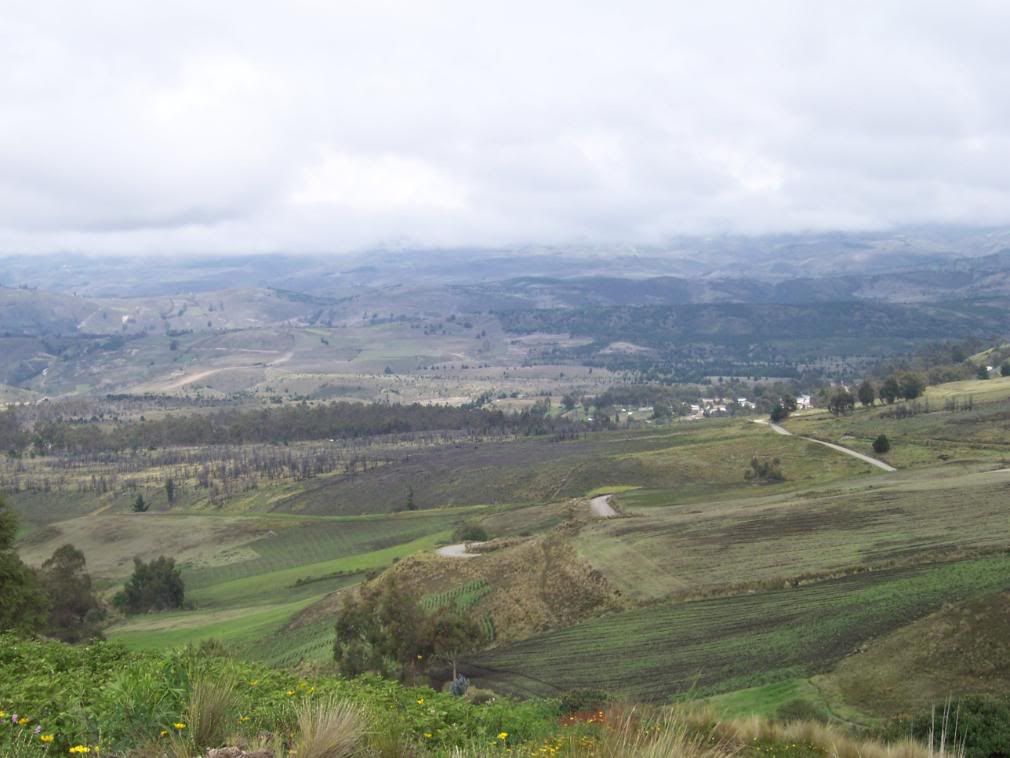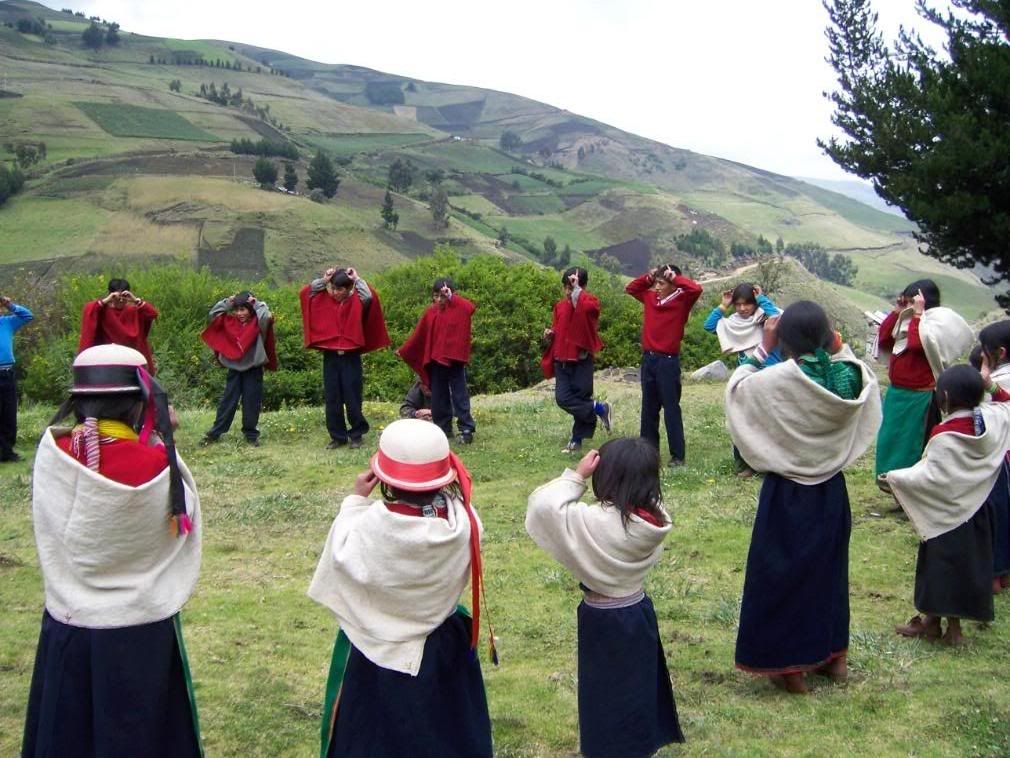Peace. Complete silence, save for the call of a bird, the gust of the wind and the occasional moo of a cow. We drove into rural Ecuador today, through the indigenous canton of Chimborazo . Along the way we hopped out of the car a couple of times to film the incredible Andean landscapes, and the tranquility and freshness of these areas was…spiritual.
 We visited a small school first with 25 indigenous students, overseen by the loving eyes of Padre Julio Galtaire. He has lived in the small town of
We visited a small school first with 25 indigenous students, overseen by the loving eyes of Padre Julio Galtaire. He has lived in the small town of Guano
We had to drive over potholed, partially flooded and unpaved roads, up a steep incline to the top of a mountain to reach it. Around us theAndes were covered in a patchwork of terraced fields, looking like nothing so much as a Frank Lloyd Wright pattern in green and brown. The Quechua people work their precarious, steep land with hoes and hands, trying to raise enough to support themselves and hoping that no outsider will exploit their labor.
The school we went to was tucked into a little crevice in the mountain, half-hidden if approached from most angles. It had about 25 students and one teacher, and classes were fully bilingual, taught in Spanish and Quechua. Most of the boys wore red ponchos and the girls beige shawls and blue skirts, and all were exceedingly shy. They and the parents, who took shifts from farmwork to check on their kids, were smiling and welcoming, but so soft-spoken that conversation seemed impossible at first. But as we spent a good amount of time at this school, people began to open up to us (and us to them).
While at the school we sat in on some classes, and the children taught us many phrases in Quechua-- yuppay chani, for thank you. Alli pancha, for good day. Then Bruce got up and taught them to say 'good day' in English, then I went to the front of the class to teach 'bonjour,' and Fernando went up there to teach 'gutentag.' It was a tremendous and fun exchange that I think everyone enjoyed.
 The location, the children, the language--all were stunning and so unlike anything I had ever encountered. Who among us expects to travel through the Andes and learn Quechua, or to meet with people who wear red ponchos and long skirts and intricate necklaces not as a gimmick, but because that's the way their parents and grandparents and great-grandparents dressed, and they see no reason to change?
The location, the children, the language--all were stunning and so unlike anything I had ever encountered. Who among us expects to travel through the Andes and learn Quechua, or to meet with people who wear red ponchos and long skirts and intricate necklaces not as a gimmick, but because that's the way their parents and grandparents and great-grandparents dressed, and they see no reason to change?
The people we met are very poor. As Padre Julio said, their way of life is rich in tradition and culture, and this must be preserved. We don't want to inundate them with Western practices and invade their culture. But they do crave education and better schools and help selling their products, because they seek social mobility. Survival is a struggle, and this is why we need programs like the bi-lingual, bi-cultural schools run by Fe y Alegria. With DVD players and projectors, they can use the best courses available to teach their children Spanish. With more school supplies, computers and books, they can teach both kids and parents to read, and allow them to make themselves known to the government. There is a tendency in Ecuador to forget about the indigenous people. But with the power of expression through literacy, and connection through internet, they can escape their marginalization and save their culture from a slow disappearing act.

 We visited a small school first with 25 indigenous students, overseen by the loving eyes of Padre Julio Galtaire. He has lived in the small town of
We visited a small school first with 25 indigenous students, overseen by the loving eyes of Padre Julio Galtaire. He has lived in the small town of We had to drive over potholed, partially flooded and unpaved roads, up a steep incline to the top of a mountain to reach it. Around us the
The school we went to was tucked into a little crevice in the mountain, half-hidden if approached from most angles. It had about 25 students and one teacher, and classes were fully bilingual, taught in Spanish and Quechua. Most of the boys wore red ponchos and the girls beige shawls and blue skirts, and all were exceedingly shy. They and the parents, who took shifts from farmwork to check on their kids, were smiling and welcoming, but so soft-spoken that conversation seemed impossible at first. But as we spent a good amount of time at this school, people began to open up to us (and us to them).
While at the school we sat in on some classes, and the children taught us many phrases in Quechua-- yuppay chani, for thank you. Alli pancha, for good day. Then Bruce got up and taught them to say 'good day' in English, then I went to the front of the class to teach 'bonjour,' and Fernando went up there to teach 'gutentag.' It was a tremendous and fun exchange that I think everyone enjoyed.
 The location, the children, the language--all were stunning and so unlike anything I had ever encountered. Who among us expects to travel through the Andes and learn Quechua, or to meet with people who wear red ponchos and long skirts and intricate necklaces not as a gimmick, but because that's the way their parents and grandparents and great-grandparents dressed, and they see no reason to change?
The location, the children, the language--all were stunning and so unlike anything I had ever encountered. Who among us expects to travel through the Andes and learn Quechua, or to meet with people who wear red ponchos and long skirts and intricate necklaces not as a gimmick, but because that's the way their parents and grandparents and great-grandparents dressed, and they see no reason to change?The people we met are very poor. As Padre Julio said, their way of life is rich in tradition and culture, and this must be preserved. We don't want to inundate them with Western practices and invade their culture. But they do crave education and better schools and help selling their products, because they seek social mobility. Survival is a struggle, and this is why we need programs like the bi-lingual, bi-cultural schools run by Fe y Alegria. With DVD players and projectors, they can use the best courses available to teach their children Spanish. With more school supplies, computers and books, they can teach both kids and parents to read, and allow them to make themselves known to the government. There is a tendency in Ecuador to forget about the indigenous people. But with the power of expression through literacy, and connection through internet, they can escape their marginalization and save their culture from a slow disappearing act.



No comments:
Post a Comment